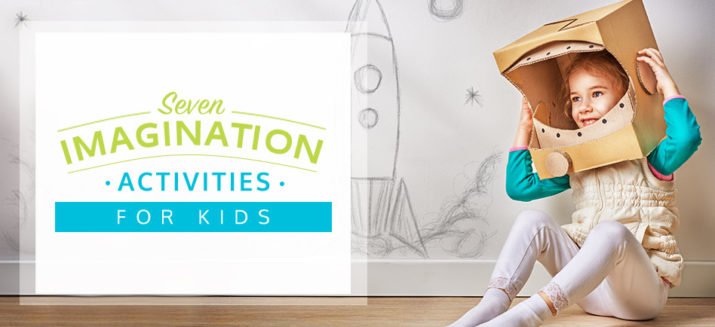
Imaginative children are generally more creative, better problem-solvers, and more confident than their peers, so child psychologists emphasize the need for imaginative play. Unfortunately, the modern world’s fixation on television, video games, and highly structured activities tends to stifle, rather than encourage, imagination. We’d like to suggest seven imagination activities for kids to help them grow and develop their creativity.
Dress Up
Dress-up and let’s pretend games have fostered imagination activities for kids for centuries. Encourage them to create their own imaginary worlds with a trunk of dress-up clothing. Old Halloween costumes, interesting clothing from thrift stores, and a selection of hats and accessories can keep kids occupied for hours. A personalized book like Super Kid! comes with a superhero cape and mask, perfect for superhero playtime!
Reading
Reading encourages children to actively use their imagination in ways movies and television simply cannot. Reading introduces children to a near infinity of worlds and characters to include in their imaginative play, while encouraging them to visualize the book’s story. A television story doesn’t require any mental effort from a child, but books ask them to imagine locations, acts, voices, and feelings. A book like I Can Change the World! builds empathy and kindness in children, teaching them that even small acts can make a larger impact.
Combine favorite books with props and toys stimulates pretend play. For instance, if your child loves a pirate book, offer toy ships, bandanas, and a plastic sword and you have all the ingredients needed for swashbuckling adventures on the high seas. Book gift sets like My Very Own Fairy Tale come with a fairy wand to transform your child into a fairy prince or princess performing magical deeds.
Boxes
Few toys hold the imaginative possibilities of a large cardboard box. To a child, a large box is a fort, a rocket ship, a palace, or a secret headquarters. Boxes just seem to generate imagination activities for kids.
If you don’t have a large box, ask your local furniture or appliance store if they have any boxes you can take. children can decorate the box with crayons and markers, and you can help cut out needed windows, doors, or portholes.
Cloud and Star-Gazing
People have created shapes in the stars and clouds for millennia. Grab a couple of blankets, lie on your back with the kids, and ask them what they see. Have contests to see who can come up with the silliest shapes for new star constellations, or try to guess what each person sees in a cloud.
Arts and Crafts
We’re big on children’s crafts at I See Me!, but right now we’re not talking about the kinds of artwork that requires close supervision from adults. Instead, we’re talking about providing children with paint, pencils, or clay and letting them create their own masterpieces.
Sure, the resulting art may not be as nice or well-formed as more complicated, adult-led crafts, but that’s not the point. You’re allowing your child to explore creativity on her own terms, which helps build a healthy imagination. Personalized coloring books offer parent and child quality time together and ignite a child’s artistic imagination!
Spend Time Outdoors
Nature has inspired the imagination of some of humanity’s most brilliant artists, so why not your child? Ever-changing, the great outdoors offers all manner of opportunities to explore and play, as well as an ongoing source of all-natural leaves, twigs, and flowers for art projects.
Let Them Get Bored
As parents, we’re expected to provide scheduled activities for children on a near continuous basis, as if boredom is the greatest disaster we could afflict on a child.
It isn’t. In fact, allowing children to get bored can stimulate their imagination. Cries of “I’m bored” can be met with a challenge to use their resourcefulness and creativity to entertain themselves. If you’ve already primed them to use their imagination, children will think of something to do (or something they aren’t supposed to do—it pays to keep an eye on things, just in case).




